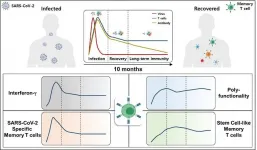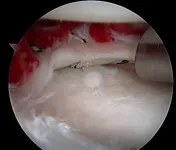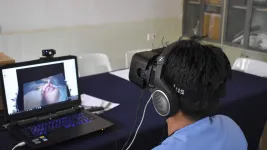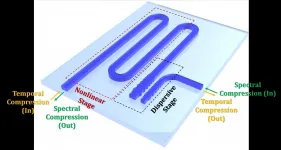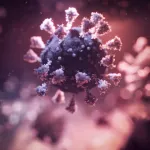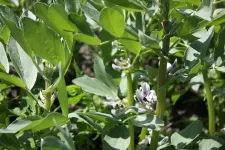(Press-News.org) Wetland, forest, and ocean are the three largest ecosystems in the world. Although the area of wetland ecosystem accounts for only 4-6% of the total land area, the carbon reserves of wetland ecosystem accounts for 12-24% of the global land carbon reserves. Under the background of global climate change, the research on carbon sequestration of wetland has become an important subject of global carbon cycle research.
The area of marshes in China ranks third in the world, and herbaceous marsh is the most widely distributed among all the types of marshes. As an important quality parameter of marsh ecosystem, aboveground biomass of vegetation is a crucial index estimating the carbon storage of marsh vegetation, and the basis for studying the carbon sequestration of marshes. At present, many scholars have studied the local or regional vegetation biomass of herbaceous marsh in China, but the aboveground biomass of herbaceous marsh on a national scale is not clear.
With the support of the National Science & Technology Fundamental Resources Investigation Program of China "Comprehensive survey on the resources of wetlands and their main eco-environmental benefits in China", more than 100 scientific researchers from 12 institutions systematically investigated wetland resources in China. It surveyed the conditions of plant, water, and ecological benefits of 440 wetland patches in China, with a total of 18390 survey quadrats (Figure 1). Aboveground biomass of herbaceous marsh were measured to obtain the most extensive and comprehensive data of herbaceous marsh vegetation in China. This survey thoroughly investigated the situation of marsh wetland and provided an important basic dataset for the protection and scientific management of marsh wetland in China. "Based on the data obtained by this large-scale survey, this work analyzed the aboveground biomass and its spatial distribution pattern of herbaceous marsh vegetation in China", Jiang Ming said.
The results showed that the total area of herbaceous marsh in China is about 9.7 × 104 km2, and the average aboveground biomass density of China's herbaceous marsh vegetation was about 227.5 g C m-2. As a result, the total aboveground biomass of herbaceous marsh vegetation was about 22.2 Tg C.
Spatially, the aboveground biomass density of herbaceous marsh in China ranges from 12 to 1400 g C m-2, with low biomass in Northeast China and the Tibetan Plateau, but high biomass in central North China and coastal regions (Figure 2). The results showed that the order of biomass density of herbaceous marsh vegetation from small to large was temperate humid and semi-humid marsh region (182.3 g C m-2) < Tibetan Plateau marsh region (243.9 g C m-2) < temperate arid and semi-arid marsh region (300.5 g C m-2) < subtropical humid marsh region (348.4 g C m-2) < coastal marsh region (675.4 g C m-2). Although the average biomass density of herbaceous marsh vegetation in the temperate humid and semi-humid marsh region is the lowest, the area of herbaceous marsh is the largest (5.3×104 km2) among the five marsh distribution regions. Therefore, the total aboveground biomass of herbaceous marsh vegetation in this region is the largest. Similarly, although the average aboveground biomass density of herbaceous marsh vegetation in the coastal marsh region is the largest, the herbaceous marsh area is the smallest (0.2×104 km2) among the five marsh regions. Therefore, the total aboveground biomass of coastal herbaceous marsh vegetation is the smallest.
The biomass spatial distribution of herbaceous marsh vegetation has obvious non-zonality characteristics, but also shows a certain zonality law in some regions. In subtropical humid marsh and coastal marsh regions, the aboveground biomass of vegetation has no obvious correlation with hydrothermal conditions and altitude. This may be because the subtropical humid marsh region and the coastal marsh region have better hydrothermal conditions, which are suitable for vegetation growth, and hydrothermal conditions are not the limiting factor for marsh vegetation growth. The non-zonality characteristics of herbaceous marsh plants in these regions are more obvious.
In the Tibetan Plateau, the biomass of herbaceous marsh decreases with the increasing elevation (Figure 3a). With the increase of altitude, the temperature decreases, and the environment worsens. Thus, the ability of plants to obtain the maximum photosynthetic energy declines, resulting in a low aboveground biomass in high altitude region.
In temperate arid and semi-arid regions and temperate humid and semi-humid regions, the aboveground biomass of herbaceous marsh vegetation first decreased and then did not change obviously with the aggravation of drought (Figure 3b, c). This may be because that the availability of soil water in temperate region decreases with the aggravation of drought.
In the temperate humid and semi-humid region, the aboveground biomass of herbaceous marsh vegetation is relatively larger in warmer regions (Figure 3d). The main reason for the low aboveground biomass density of vegetation in cold region may be that the poor climate and other environmental conditions in these regions lead to short herbaceous plants with low coverage.
This study can provide scientific basis for carbon sequestration evaluation and adaptive management of marsh wetland in China.
INFORMATION:
See the article: Shen X, Jiang M*, Lu X, Liu X, Liu B, Zhang J, Wang X, Tong S, Lei G, Wang S, Tong C, Fan H, Tian K, Wang X, Hu Y, Xie Y, Ma M, Zhang S, Cao C, Wang Z. 2021. Aboveground biomass and its spatial distribution pattern of herbaceous marsh vegetation in China. Science China Earth Sciences, 64, https://doi.org/10.1007/s11430-020-9778-7
A KAIST immunology research team found that most convalescent patients of COVID-19 develop and maintain T cell memory for over 10 months regardless of the severity of their symptoms. In addition, memory T cells proliferate rapidly after encountering their cognate antigen and accomplish their multifunctional roles. This study provides new insights for effective vaccine strategies against COVID-19, considering the self-renewal capacity and multipotency of memory T cells.
COVID-19 is a disease caused by severe acute respiratory syndrome coronavirus-2 (SARS-CoV-2) infection. When patients recover from COVID-19, SARS-CoV-2-specific adaptive immune memory is developed. The adaptive immune system consists ...
While this isn't the fountain of youth, scientists may have improved healing in our joints - even in areas that become weaker as we grow older. The meniscus is a durable, yet flexible tissue found in joints like our wrist and knees that helps them absorb shock during movement. Occasionally tears can occur in the meniscus due an awkward movement or structural weakness from old age. When we are young, there is plenty of blood flowing to this area allowing for quick healing, but as we get older, the meniscus receives less and less blood - with the inner most area becoming ...
An international team including Lancaster University researchers has created a strategy for understanding the evolution of the COVID-19 pandemic throughout the African continent.
Their COVID-19 surveillance strategy will improve the ability of African countries to interpret the complex data available to them during the pandemic.
Professor Peter Diggle, Dr Chris Jewell and Dr Claudio Fronterre from the Centre for Health Informatics, Computing and Statistics (CHICAS) at Lancaster Medical School worked with colleagues in the USA, Uganda and Switzerland to create a data-driven disease surveillance framework to track and predict ...
Cleft lip and palate is one of the most common congenital malformations. Its causes are mainly genetic. However, it is still largely unknown exactly which genes are affected. A new international study led by the University of Bonn now provides new insights. The results are published in the journal Human Genetics and Genomics Advances, but are already available online.
The researchers from the Institute of Human Genetics at the University Hospital Bonn combined various data sources in their work. In the course of their research, they discovered five new regions in the human genome in which variations in the DNA sequence are associated with an ...
A new report that could help improve how immersive technologies such as Virtual Reality (VR) and Augmented Reality (AR) are used in healthcare education and training has been published with significant input from the University of Huddersfield.
Professor David Peebles, Director of the University's Centre for Cognition and Neuroscience, and Huddersfield PhD graduate Matthew Pears contributed to the report - 'Immersive technologies in healthcare training and education: Three principles for progress' - recently published by the University of Leeds with input from range of academics, technologists and health professionals.
The principles have also been expanded upon in a letter to the prestigious journal BMJ ...
A train carrying cargo has finite space. The amount of cargo that can be carried onboard is limited by the size of the cargo and the capacity of the train. Analogously, the amount of time taken up by an optical signal limits the amount of data that can be carried. Temporally shorter signals allow more data to be squeezed into a given time duration, in a method called optical time division multiplexing. Photonics researchers have recently succeeded in squeezing light in time by 11 times. The developed temporal compression system allows an equivalent increase in the number of bits transmitted by light ...
A new international study has found that the key properties of the spikes of SARS-CoV-2 virus which causes COVID-19 are consistent with those of several laboratory-developed protein spikes, designed to mimic the infectious virus.
A central component in designing serological tests and vaccines to protect against COVID-19 is the manufacture of protein "spikes". These recombinant spikes closely mimic those sticking out of surface of the infectious virus and trigger the body's immune system into action.
Laboratory manufactured spikes are also used for serological testing (also referred to as antibody testing) and as research reagents. The findings show how that viral spike manufactured through different methods in laboratories across the globe ...
Since July 2020, remdesivir has been conditionally approved in Europe for the treatment of coronavirus disease (COVID-19) in adults and adolescents aged 12 years and older with pneumonia who require supplemental oxygen but no invasive ventilation. In an early benefit assessment, the German Institute for Quality and Efficiency in Health Care (IQWiG) has now investigated whether the drug, which was originally developed for the treatment of Ebola virus disease, offers these patients an added benefit compared to the appropriate comparator therapy (here: therapy according to physician's choice).
This investigation yielded an indication of a considerable added benefit of remdesivir compared to the appropriate comparator therapy for adults with pneumonia ...
In a study published in Physical Review Letters, academician GUO Guangcan's team from University of Science and Technology of China of the Chinese Academy of Sciences made progress in the open quantum system research. This team, collaborating with Austrian theoretical physicist Philip Taranto, demonstrated the non-Markovianity in the multi-step evolution of the open quantum system, and proved the measurement-dependent property of quantum memory effects.
In quantum information science, it is crucial to understand and control the memory effects for the development of quantum technology. For the coupling of the system and environment, the evolution of open quantum system presents the non-Markovianity, ...
Faba beans have been an excellent source of food protein since pre-historic times, but about 5% of people, mostly from regions where malaria has been endemic and who carry a certain mutation, can't eat them. Now, an international team of researchers, led by the Universities of Helsinki and Copenhagen as well as Luke Natural Resources Institute Finland, has identified the gene responsible for the production of vicine and convicine, which are harmful to these people. In the work published in Nature Plants, the team reports that the VC1 gene plays a central role in the biosynthesis these compounds.
Faba beans - Pythagoras and his followers avoided them and Roman priests of Jupiter associated them with death. ...

